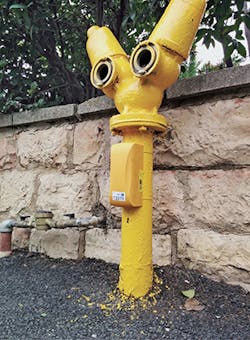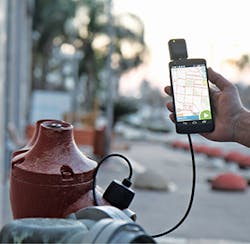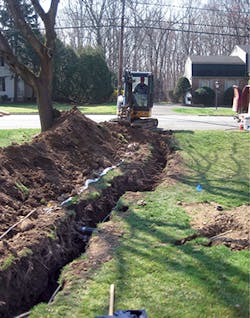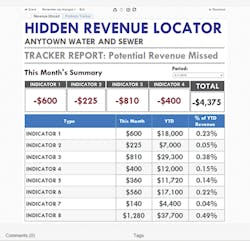Non-revenue water (NRW) is the difference between the amount of water that is produced by a water utility for consumption/use, and the amount of water that is actually billed to customers.
Often, people fail to put the seriousness of the non-revenue water problem for water utilities into perspective. Jeff Lipton, director of marketing for WaterSmart, helps to provide some insight. Based on his estimates that the average water utility loses about 20% of its water to NRW: “Imagine any other business in the world that would lose one-fifth of all its product to ‘breakage,'” he says.
NRW is a huge and costly problem—for utilities in the US and around the world. According to Ivan Nazzaretto, product manager for Smart Water Software with Schneider Electric, NRW is one of the most important sustainability issues in the water industry. It leads to avoidable operational expenditures (mainly energy), reducing water availability in resource-scarce areas, and increasing or diverting capital expenditures to find additional water sources to satisfy new or unmet customer demand.
“Sensitivity to water loss has not always been directly proportional to the magnitude of the problem,” says Nazzaretto. “Traditionally, water-rich geographies used to have a low perception of the direct costs and the impact of water loss on the environment. However, this attitude is rapidly changing in many countries as more stringent regulations are being applied, and customers and shareholders are acting as watchdogs of the efficiency of the water industry.”
How much of a problem is NRW globally? According to Zeev Efrat, CEO of Aquarius-Spectrum: “The average gap [between water produced and water properly paid for] ranges between 25 and 50% of the total water distributed globally,” he says.
iQuarius uses acoustic correlation technology to enable
easy surveying, leak detection, and pinpointing.
And, according to one report, The Drivers of Non-Revenue Water: How Effective Are Non-Revenue Water Reduction Programs? published by the World Bank Group in August 2014, the total cost to water utilities caused by NRW on a worldwide basis is estimated to be $141 billion per year.
While one might imagine that NRW is more of an international rather than domestic problem, because of the availability of advanced technology in the US and often primitive water systems in other countries, NRW is also a serious problem stateside. “In 2007, the EPA estimated the amount of water lost in the US from distribution systems was 1.7 trillion gallons per year, with a national cost of $2.6 billion per year,” says Nazzaretto. “And, according to the American Water Works Association [AWWA], between five and ten billion kWh of power generated in the US in 2009 was consumed in the treating and pumping of water that was either leaked or not paid for by customers.”
In 2013, EPA estimated that the US “will need to spend over $200 billion on water systems over the next 20 years to upgrade transmission and distribution systems. Of this amount, $97 billion (almost half) is estimated to be needed for water loss control.”
In perspective: “NRW is a massive problem for water utilities in the US and around the world,” says WaterSmart’s Lipton. “It is estimated at an average of 20% of all supply production—treatment and conveyance. Ten percent NRW levels are considered well within the bounds of good water management, but certain systems see losses of 30% and above.”
NRW Causes
NRW causes are generally categorized into three areas. They are, in order of significance: physical losses (leaks), commercial losses (meter and paperwork problems), and “everything else.”
Physical Losses
Physical losses are, by far, the most common, widespread, and costly for most water utilities. These are losses that result from leakages from various parts of the distribution system, as well as overflows at utility storage tanks. Such losses can be caused by ineffective operations and maintenance, the absence of leakage control programs, and poor quality or aging underground assets. Water utilities may have hundreds or even thousands of miles of mains, so detecting where leaks are located in the first place can be a major challenge.
“These are real losses of water—volumes lost through all types of leaks, bursts, and overflow on mains, service reservoirs and service connections, up to the point of customer metering,” says Schneider Electric’s Nazzaretto.
According to Aquarius-Spectrum’s Efrat, utilities are losing between 10 and 40% of their treated water due to leaks. “Very often, these leaks are gradually developing underground without being visible, until pipes burst,” he says. “The reasons are pipe aging, worn-out infrastructure, and improper maintenance.”
Water line repair
As Efrat sees it, the best way for utilities to reduce water loss as a result of leaks is to carry out continuous monitoring in order to assess the condition of the pipes in each area, and manage the maintenance accordingly. “However, because some of the methods to do so are relatively complex and require skilled labor and large investments, many utilities are not able to utilize this process,” he says.
While catastrophic main breaks are of significant concern to water utilities when it comes to physical losses, they are not the only problem, according to Myles Meehan, senior vice president of public relations for HomeServe. “A hole the size of a dime was recently linked to a leak that wasted 1.4 million gallons of drinking water every month in Minnesota,” he says.
According to WaterSmart’s Lipton, a 2013 infrastructure report by the American Society of Civil Engineers estimated that US water distribution networks experience 240,000 main breaks each year, due to dramatic underinvestment. Cost estimates on infrastructure replacement range from $1 trillion to nearly $5 trillion over the next 20 years.
“One of the reasons our water infrastructure is in such disrepair is that water is too inexpensive,” says Lipton. “Most water systems can’t afford to invest in upgrading distribution systems due to a lack of revenue. In some cases, operating costs exceed water revenues, particularly in times of drought that lead to greater conservation and reduced revenue.” This leaves no reserves for long-term capital investments. By pricing water at the marginal cost of procuring additional supply (including the cost of infrastructure rehabilitation), utilities would be able to create more sustainable water systems, improve network efficiency, and ensure high quality and reliable service. “This means that everyone needs to pay more for water,” says Lipton. “Without a financial restructuring of how we run our water systems, including a significant reduction in the amount of subsidies provided to cities and agricultural interests, we will see increased NRW levels, more main breaks, and more boil orders due to contamination.”
Commercial Losses
Commercial losses are those that are the result of customer meter under-registration, data handling, or billing errors—and even theft of water. Assessing each meter to make sure it is registering accurate usage, of course, is a major challenge. Identifying instances of theft can also be difficult. Schneider Electric’s Nazzaretto refers to these as “apparent losses, which include unauthorized consumption and metering inaccuracies,” he says.
WaterSmart’s Lipton agrees with the assessment. “A small portion of NRW is due to bad water meters, or gradually declining accuracy of consumption telemetry, where the utility can’t measure or charge for the water being consumed,” he says. “Another cause is outright theft. However, these are secondary causes. The main culprit, by an order of magnitude, is system leaks.”
“Everything Else”
Purposely unbilled (but still authorized) water use is another cause of NRW. This can include water that is being used by the utility itself, water that is used for firefighting, water that is provided free of charge to certain groups, and situations in which utilities cover part of the cost of lost water resulting from leaks on homeowners’ or business owners’ properties that should otherwise be billed to those customers (discussed in more detail later).
While “Everything Else” is, indeed, a partial contributor to NRW, physical losses and commercial losses, according to Nazzaretto, are the two major sources of NRW. “One reason is that, for a lot of water utilities, their pipes and water meters—instead of being treated as assets to be managed during their entire lifecycle—often suffer the ‘install and forget’ practice,” he says. “The fact that most pipelines were installed before the era of digitization does not help. In sum, technical difficulties in assessing the conditions of pipelines and spotting problems, as well as indifference, are usually the main causes of high levels of NRW.”
NRW Solutions
How can and should water utilities address the problem of NRW? The first step, for better or worse, is usually also the most difficult, time-consuming, and expensive—identifying where, when, why, and how much water is being “lost.”
One way to do this is to divide the utility’s water distribution system into district metered areas (DMAs). This involves dividing the water district into small, well-defined segments and then installing flow meters at specific locations in each DMA. This allows the utility to monitor water flows in each DMA and thus isolate specific areas where leaks or other losses (e.g.: inaccurate meter readings, theft, etc.) may be occurring. Initiatives designed to address these losses can then be targeted to the DMAs that are registering the greatest losses first.
Once this information has been collected, the next step is not necessarily to create and implement strategies to reduce the losses. Rather, it is to determine if it is worth the time, effort, and cost to address each specific loss. That is, it does not make sense to address all NRW problems; cost must be taken into consideration. The August 2014 World Bank Group report cited earlier noted that “an important conclusion is that the design of non-revenue water reduction programs should study the main drivers of non-revenue water to provide utility managers with a better understanding of what can be achieved in terms of non-revenue water reduction and whether the benefits of these reductions exceed their costs.”
Solutions can comprise a number of options. One is a comprehensive program. Others are programs that focus specifically on leaks—or on meters.
Comprehensive Solutions
Many solutions are available in the market to address NRW. “However, so far, most of them focus exclusively on leak detection or smart metering,” says Schneider Electric’s Nazzaretto. “Schneider Electric, on the contrary, provides solutions for comprehensive leakage management, following a holistic approach, and by interconnecting all utility departments around this issue, managing the team and resources, presenting performance results as needed by each department, and providing support to the decision-making process to efficiently manage the water distribution network.”
Working from the principal that virtually all corporate information technology (IT) systems and field sensors and devices in the water network can contribute to advanced leakage management, Schneider Electric provides software, sensors, communications, automation, and controls. The core of the company’s offering is software that is specifically designed for water network operators and leakage practitioners.
One of these is WMS Water Loss. “WMS Water Loss is our leakage management system, which provides automatic leakage calculation and real-time alarming for early warning,” says Nazzaretto. It also supports the International Water Association’s four pillars for water loss reduction—active leakage control, pressure management, speed and quality of repairs, and pipeline and asset management—embedding a business intelligence platform for continuous performance monitoring. “It provides reliable NRW calculations, identifies critical geographic zones and new events, helps manage leak detection teams, and monitors leak repair activities,” he says. “This shortens action times and improves overall efficiency.”
Another is Aquis. “Aquis is our specialty software for online water network optimization, powered by an advanced hydraulic model engine,” says Nazzaretto. It provides specific tools for NRW management, including pressure management (dynamic pump scheduling and automatic feed-forward set-points of pressure-regulating valves), and leak localization. By applying an advanced real-time pressure management system, utilities can reduce leakage levels and new burst occurrences, thus reducing energy consumption, CO2 emissions, and leak repair and detection costs.
“Overall, our solutions can provide up to 20% water loss and operating cost reductions, plus significant time savings in calculation, regulatory reporting, and planning tasks,” says Nazzaretto.
WaterSmart also offers a comprehensive solution. “We offer water utilities a customer engagement and data analytics platform that drives persistent improvements in water use efficiency, using behavioral cues to compare household usage with similar residents,” says Lipton. “This approach has been proven to reduce water consumption by an average of 5%.” By reducing demand at the customer end, water utilities can improve NRW levels as a result of less throughput (and thus less loss), as well as a reduction in system pressure, which further reduces loss levels. “If a utility can reduce customer demand in a controlled manner by 5%, then a 20% NRW level becomes a 19% NRW level,” he says.
Widely available software for the industry as a whole is also useful. In recent years, new emphases from AWWA, EPA, and state-level agencies have brought about tools related to conducting water audits to determine levels of water losses. Since it was introduced in 2008, the AWWA Free Water Audit Software, which is based on best practices from the International Water Association (www.iwa-network.org), has been used by over 500 utilities to conduct audits.
Leak (Physical Loss) Solutions
Aquarius-Spectrum specializes in advanced monitoring solutions for urban water networks’ leak detection and maintenance. “The technology provides a daily vision of the monitored water network,” says Efrat. “In addition, since NRW is an outcome of the deterioration of the pipes, a fixed monitoring system enables the utility to make better decisions about pipe replacement. This is the most cost-effective way to reduce and better use limited budgets for pipe replacement programs.”
Aquarius-Spectrum has two product lines that enable water pipes to become Internet-monitored equipment. One is the AQS-SYS fixed-sensor monitoring solution, which is based on acoustic daily monitoring, using fixed all-time correlating sensors. “One benefit is the ability to locate pipe leaks from a very initial stage, when they are still very small,” says Efrat. “As an example, more than two thousand sensors are operating in four cities in Israel, monitoring more than 1,000 kilometers of water pipes daily. Due to system alerts, over 100 leaks were found and repaired.”
The other Aquarius-Spectrum offering is the iQuarius, which is a set of smartphone tools enabling easy surveying, leak detection, and pinpointing, using new acoustic correlation technology. “The technology provides fast, efficient and accurate surveying and pinpointing of water leaks,” says Efrat.
While locating and repairing leaks in water mains and other major sections of pipe networks is important to reducing NRW, locating and repairing leaks on customer property is also important. “Similar to the infrastructure challenges that municipalities and utilities face in the public right of way, homeowners face leakage issues on service lines and plumbing systems in the home,” says HomeServe’s Meehan. “To enable the reduction of significant volumes of NRW and general water loss, leak awareness and prompt repair are key.”
Water utilities that partner with HomeServe provide a turnkey program for their homeowner customers that offers year-round, around-the-clock service support from qualified local technicians who can identify the source and repair pipe leaks to minimize water loss. “This speeds up the repair process from identification to completion, shaving days off the process and saving significant water loss,” says Meehan. “In California, for example, where water conservation is a top priority, HomeServe’s service plans have saved an estimated 690 million gallons of water by facilitating service line repairs more quickly for homeowners.”
However, if the leaks are on customer property, how does this help water utilities address the NRW problem, since, it would seem, customers would be the ones responsible for paying for the water lost on their property? Two ways, according to Meehan, depending on the location of the water utility.
“In many areas of the country, nearly all of the northern half, the water meter is located inside the home, typically in the basement, because these are areas prone to freezing temperatures and deeper frost lines,” says Meehan. “In these areas, the service line from the water utility’s connection at the street/property line to the home is the homeowner’s responsibility. However, leaks on this line represent NRW for the water utility, because it is before the meter.”
In more temperate climates, where the meter is located at the street/property line, leaks occurring after the meter on the customer-owned service line (or inside the home) are the homeowner’s responsibility. “Leaks on this line can create significant water bills for the homeowner,” says Meehan. “However, often, the water utility will split the cost of this bill with the customer, which is then lost revenue to the water utility, and thus NRW.”
Meter (Commercial Loss) Solutions
One company that provides technology to address meter-related NRW problems is Valor Water Analytics. Valor provides software that analyzes customer data and meter data. It can track all of the anomalies on a meter, even beyond NRW, to discover what are called “non-revenue-performing meters.” This involves tracking everything that can be going wrong with a meter such as leaks, broken meters, meter tampering, etc., so that utilities can collect the right amount of revenue for any given meter. “We run the algorithms to flag these meters and present them back to the utility for action,” says Christine Boyle, Ph.D., founder and president. “Based on results from the different utilities we work with around the country, we have found that, on average, 2.3% of meters have some type of revenue-related problem.”
Some of the reasons for “non-revenue-performing meters” are that the meters have become old, are nearing the end of their service lives, and are thus no longer functioning properly. However, according to Dr. Boyle, there can also be problems with new meters. “New meters are much more technically-complex, such as reporting via antenna or cellular network,” she says. This complex technology doesn’t always work properly. In addition, information from the meters is reported electronically to different departments in the utility, which can lead to data errors.
NRW Efforts in Action
One utility with an extremely effective NRW program is the City of Asheville, NC, Water Resources. “Our NRW had not really been a priority for a number of years prior to 2012,” says Ivan Thomas, operations manager. “We had reporting and tracking methods in place, but overall NRW was steadily increasing.”
Although water is plentiful in the region, the utility became aware that surrounding states were instituting mandatory auditing and state-regulated reporting. “Instead of waiting for our state to implement such measures, we thought it to be good practice to implement the program in our system proactively,” says Thomas. “With the higher pressures and mountainous terrain, coupled with high water loss numbers, what better place to start a more detailed practice for NRW?”
The utility has instituted a number of effective strategies since 2012. “First, employee engagement and education of NRW are a must,” he says. “We created several teams that focus on different aspects of NRW, for a total team focus.”
In addition, a robust approach to proactive leak detection and a smart approach to testing, replacing, and repairing meters are two other initiatives that Thomas says have been “heavy hitters” for the utility.
“We are also turning over old billing and meter records, in addition to searching unmetered fire lines for NRW,” he says. “Altogether, the programs, in addition to a high level of communication between the teams, have made the programs successful to date.”
How successful? Overall, the utility has been able to reduce its water loss by 10%, from six million gallons per day to 5.3 million gallons per day, since implementing its initiatives. “The overall cost savings, according to our last audit, is somewhere in the one million dollar range annually,” says Thomas.
The unintended benefits of taking a proactive approach have been significant as well, according to Thomas. “More revenue from accurate meters and fewer claims for property damage due to proactive leak detection have been nice additions to the list of benefits from the program,” he says.
Other smaller side projects have also proven successful. “We recently completed an audit of all of our city, county, and volunteer fire departments that use city water to protect our community,” he says. The audit was an opportunity to ensure that all 20-plus stations were reporting water that is pulled from hydrants, to make sure it is tracked and reported in a consistent manner. “In addition, we corrected billing inconsistencies to create a more streamlined approach to water that is not being used for firefighter training and firefighting in general,” he says.



